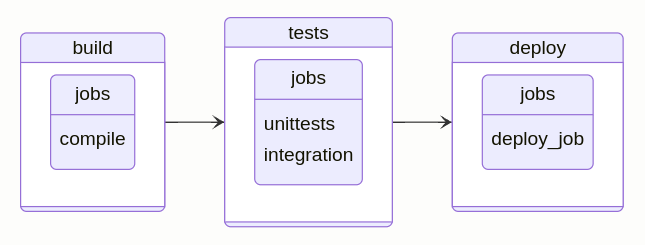gr pp
gr pp is a command that allows you to handle pipelines from the command line.
- List pipelines
- Lint pipeline configuration (
.gitlab-ci.yml) - Get runners available for the project (Gitlab)
- Get the merged .gitlab-ci.yml
- Mermaid diagram of .gitlab-ci.yml
List pipelines
To list pipelines for the current project, you can use the following command:
gr pp list
Lint pipeline configuration (.gitlab-ci.yml)
To lint the pipeline configuration file (.gitlab-ci.yml), you can use the following command:
gr pp lint
Get runners available for the project (Gitlab)
To get the runners available for the project, you can use the following command:
gr pp rn list <status>
Where <status> can be one of the following values:
onlineofflinestalenever-contactedall
Get the merged .gitlab-ci.yml
In the scenario where you use a Gitlab pipeline declared in .gitlab-ci.yml and
the pipeline contains include statements, you can use the following command to
obtain the total configuration of the pipeline:
gr pp merged-ci
This will print out to the console the total merged .gitlab-ci.yml file that
includes all the contents from the included yaml files. If the pipeline has
errors it will print out the errors if any.
Mermaid diagram of .gitlab-ci.yml
This command is intended to provide a quick and general idea about the project's
pipeline structure by computing a state Mermaid diagram off of the
.gitlab-ci.yml contents. The implementation is not exhaustive and does not
cover all the possible cases that can govern a pipeline creation. It just
computes the stages involved, its jobs and the links in between them. The
command does not compute whether a stage belongs to a specific branch or to a merge
request event.
gr pp chart
For example, given the following .gitlab-ci.yml:
stages:
- build
- tests
- deploy
compile:
stage: build
script:
- echo "build the project"
unittests:
stage: tests
script:
- echo "Run unit tests"
integration:
stage: tests
script:
- echo "Run integration tests"
deploy_job:
stage: deploy
script:
- echo "Deploying the project..."
The corresponding Mermaid diagram that would get generated would look like this:
stateDiagram-v2
direction LR
state build{
direction LR
state "jobs" as anchorT0
state "compile" as anchorT0
}
build --> tests
state tests{
direction LR
state "jobs" as anchorT1
state "unittests" as anchorT1
state "integration" as anchorT1
}
tests --> deploy
state deploy{
direction LR
state "jobs" as anchorT2
state "deploy_job" as anchorT2
}
If you copy the above diagram and paste it in a markdown file or in the mermaid live editor https://mermaid.live, you will get the following diagram:
